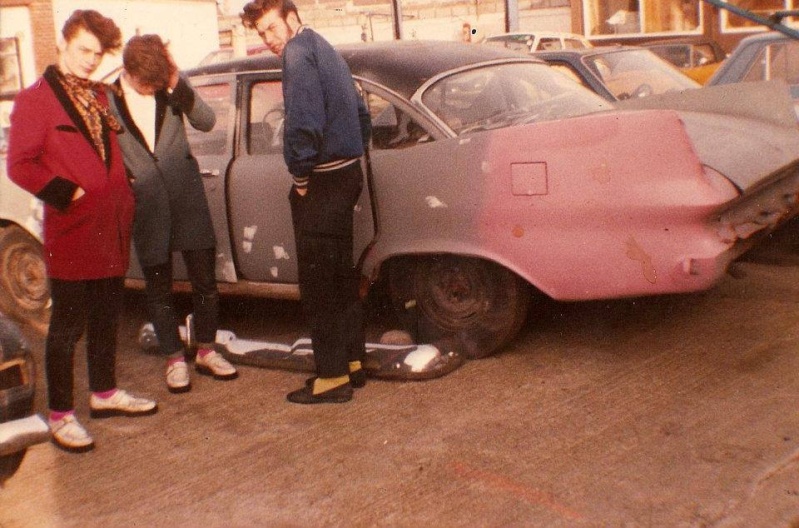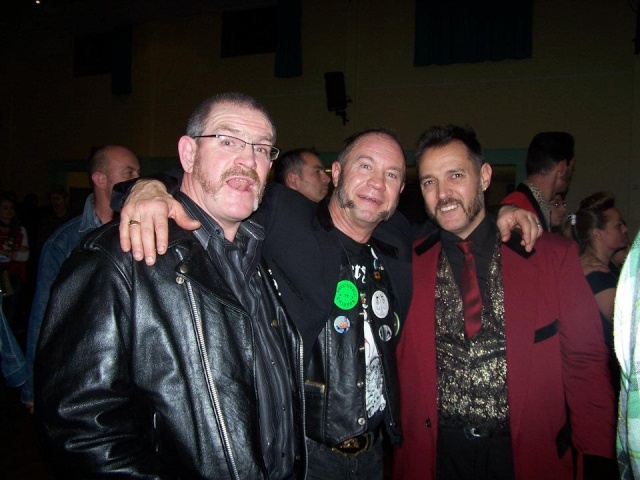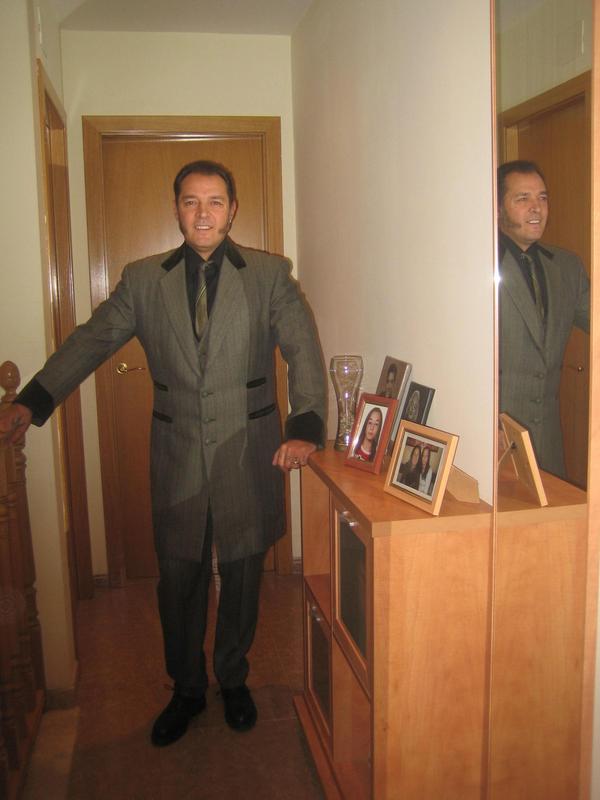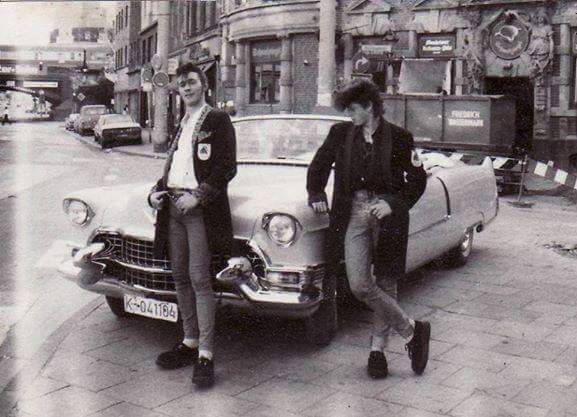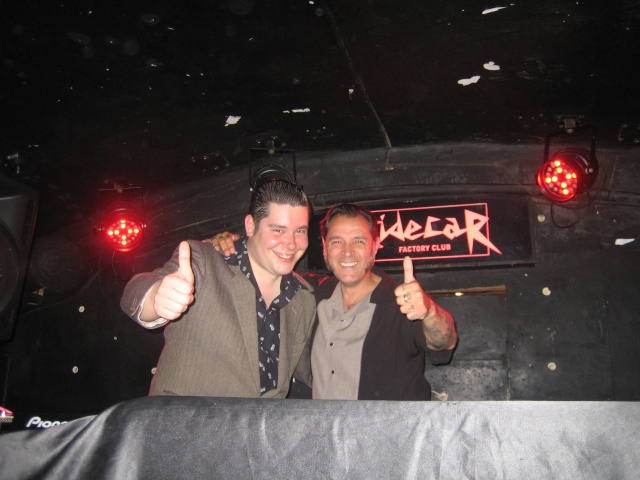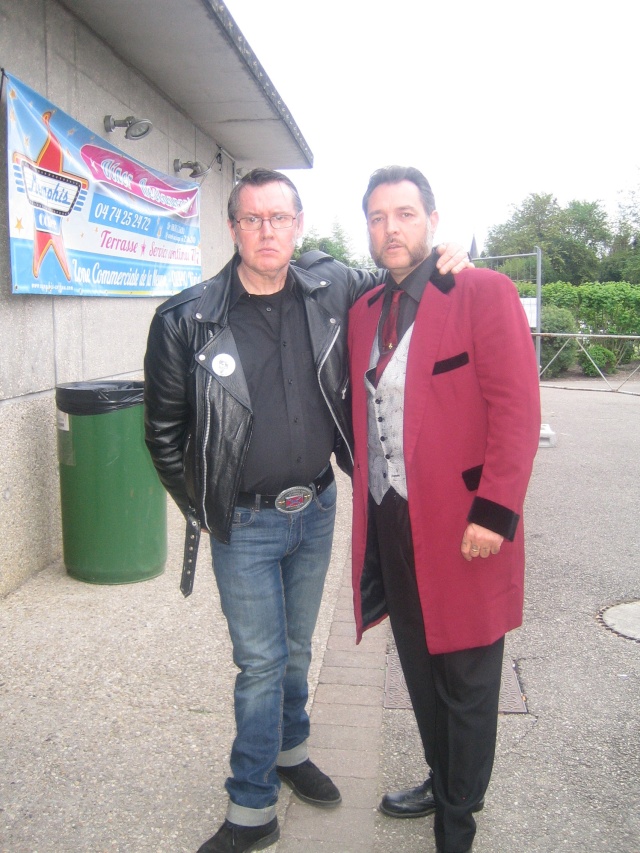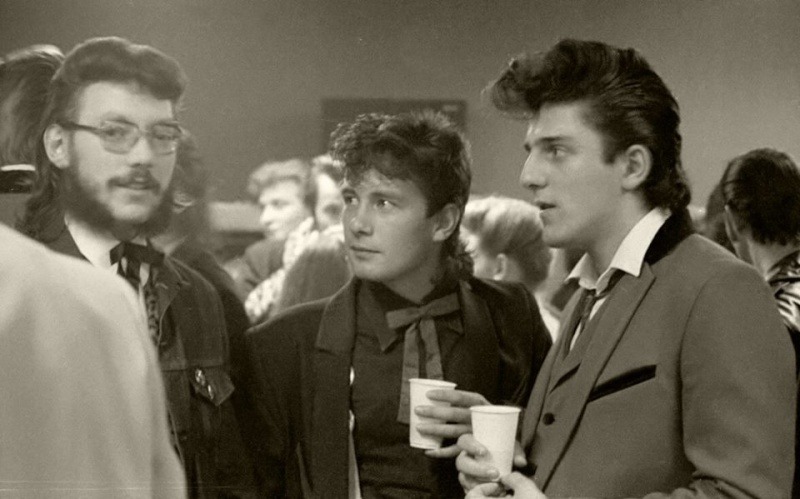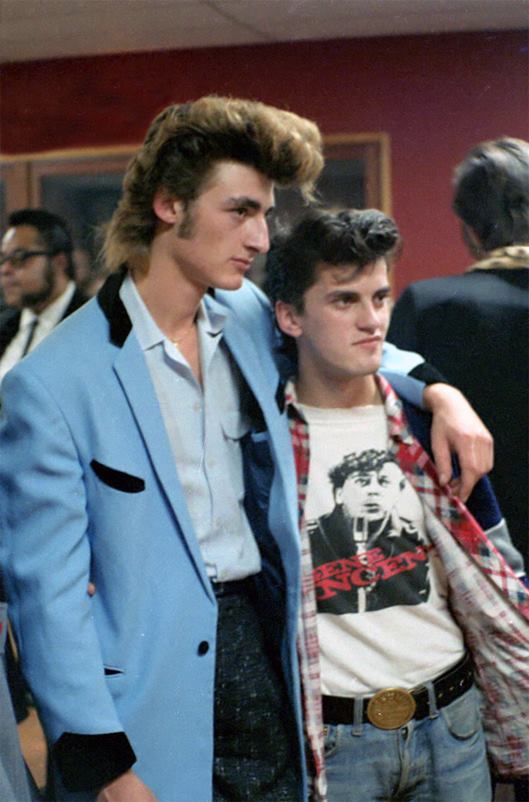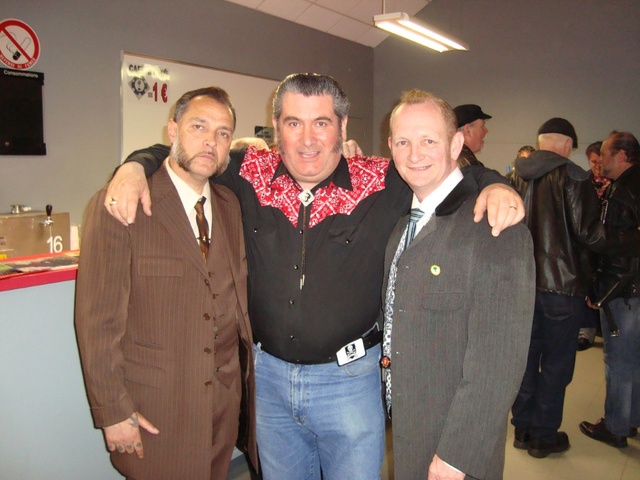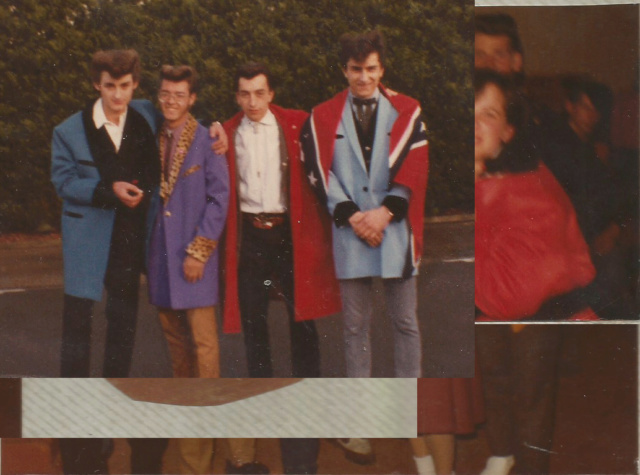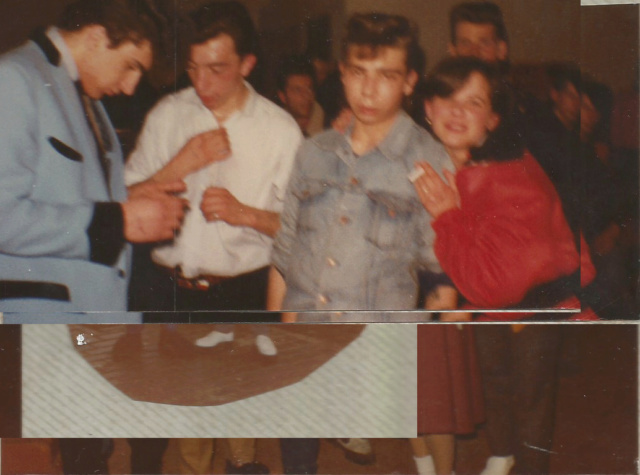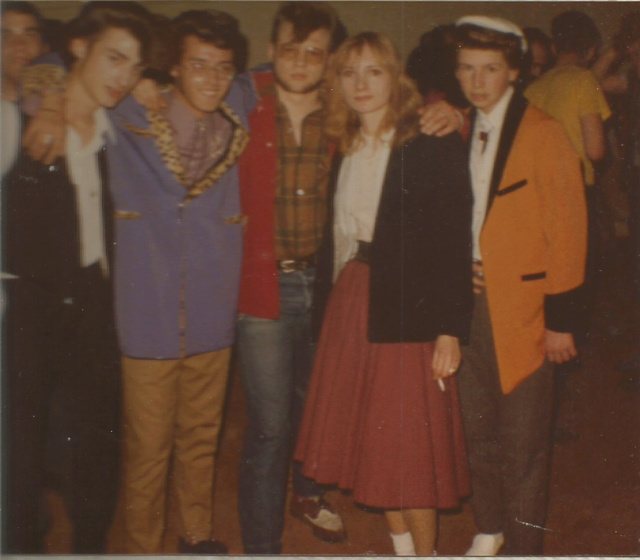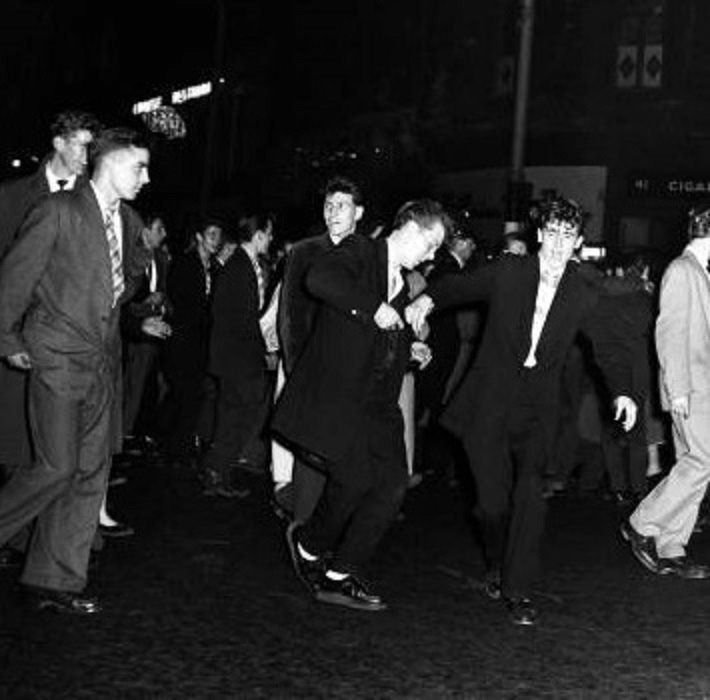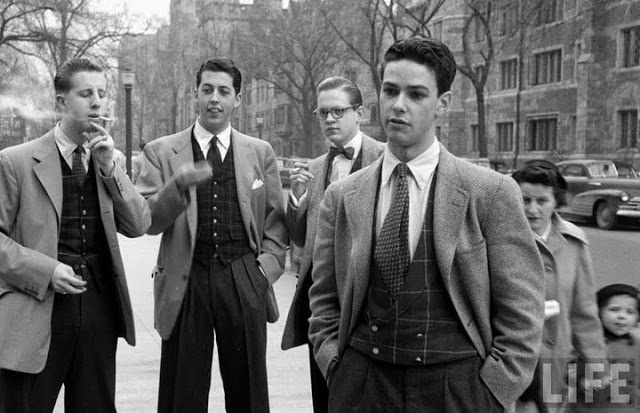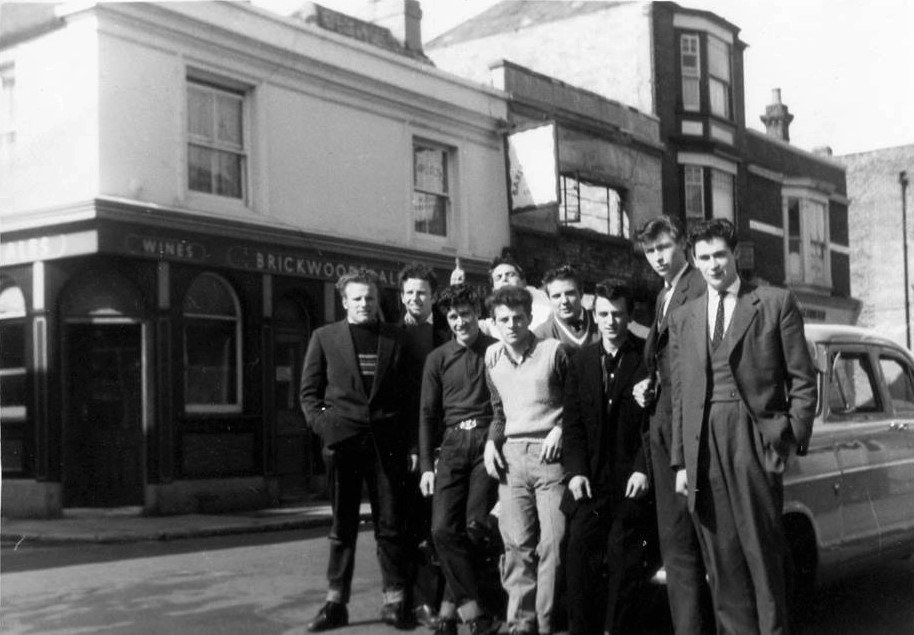Teddy Boys
4 participants
Page 4 sur 6
Page 4 sur 6 •  1, 2, 3, 4, 5, 6
1, 2, 3, 4, 5, 6 
 Re: Teddy Boys
Re: Teddy Boys
_________________
We don't care the People Says , Rock 'n' roll is here to stay - Danny & the Juniors - 1958
 Re: Teddy Boys
Re: Teddy Boys
'fait froid !
ou lendemain de teuf ....
ou encore dépit, devant le boulot à faire sur cette mop' 59 ??


ou lendemain de teuf ....
ou encore dépit, devant le boulot à faire sur cette mop' 59 ??

fomoco- Messages : 1282
Date d'inscription : 03/04/2013
Age : 52
 Re: Teddy Boys
Re: Teddy Boys
Des belles photos, juste une petite rectification, la photo accompagnée par le commentaire : Gerald les voici les Teds de ton enfance photos Paris fin 1970's.
C´est Teds sont effectivement de la région Parisienne, mais pas de la fin des années 70s, cette photo date au moins de 1984/5, je peux vous dire les noms de tous eux.
Je vous laisse à mon tour quelques photos de Teds.
Dj EddieCesc


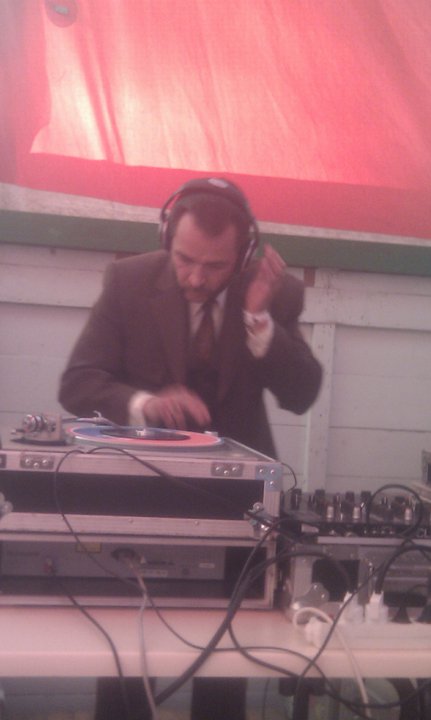
Mais aussi quelques vidéos: https://www.youtube.com/watch?v=QsYLGYCFOFc
Dj EddieCesc
C´est Teds sont effectivement de la région Parisienne, mais pas de la fin des années 70s, cette photo date au moins de 1984/5, je peux vous dire les noms de tous eux.
Je vous laisse à mon tour quelques photos de Teds.
Dj EddieCesc



Mais aussi quelques vidéos: https://www.youtube.com/watch?v=QsYLGYCFOFc
Dj EddieCesc
Dj Eddie-Cesc- Messages : 576
Date d'inscription : 03/07/2015
 Re: Teddy Boys
Re: Teddy Boys
15 Mai 1976, ‘teddy boys’ (and girls) from all over Britain marched on the BBC’s headquarters in London, to protest the lack of authentic rock’n’roll on the radio. More than five thousand turned up, and their message came over loud and clear: in the words of Danny and the Juniors – rock and roll is here to stay! The march proved a great success, and one of the organisers was given his own show.
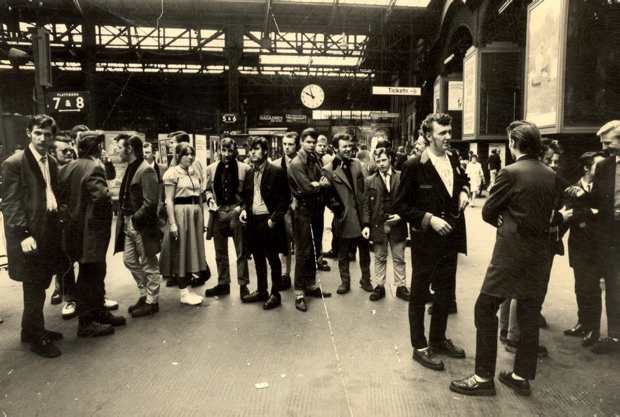
The teds that marched were a mixture of original ‘Edwardians’ and younger followers of 1950s rock. They wore their hair in greased quiffs, and dressed in ‘drape’ jackets, drainpipe trousers, brothel creepers and winkle-pickers. The girls wore blouses and flared skirts. Together they represented a thriving underground scene based in pubs and clubs the length and breadth of the country. The article below, from the South East London Mercury gives a flavour of the Seventies scene…[/i]
STANDING ROOM ONLY AS PLUCKY TEDS WED
From the South East London Mercury, 1976
It was South London’s wedding of the year, and everyone who is anyone in the world of 1950s-style rock’n’roll was there to see Leonard Potts marry his beautiful bride Susan Smith.
The story of their romance is worthy of the silver screen. Leonard, aka ‘Legless Lenny’, is a teddy boy of 21 years’ standing – and for most of them, he has been standing on a pair of metal legs, after a motorcycle accident in his teenage years. But although the crash left him ‘All Shook Up’ for a while, he underwent a miraculous recovery at the Manor House rehabilitation centre in West Drayton.
Lenny was soon back on the rock’n’roll scene, and has stayed there ever since. He organised last year’s Teddy Boys’ Picnic to raise money for the Manor House, and invaded the stage at Bill Haley’s recent London concert to shake a collection bucket. When the teds marched on the BBC this year to protest at the lack of their favourite music on the airwaves, it was Lenny who led the way – at a pace that left his able-bodied comrades ‘Breathless’.
He can still be found bopping with the best of them at The Castle and The Black Bull, displaying the ‘propeller’ technique that has made him a legend – straightening his legs in opposite directions and spinning around on the floor. No other dancer comes close – quite literally!
It was a highly unusual combination of charity work and propellers that brought Lenny and his future bride together. For some years, Lenny had been performing at charity events with his old friend the Reverend ‘Skinny Jim’ Laine. Laine was a colleague of the Rev. John Robertson, better known as the ‘Rocking Vicar’ who hit the headlines in the 1950s when he greased his hair and motorcycled around his parish at the Elephant and Castle.
Lenny raised money by sitting astride an upturned aeroplane propeller attached to an engine. Once strapped on, he would spin to the sound Danny and the Juniors while Laine, clad in his ‘Heaven’s Angels’ jacket, collected money in his crash helmet. It was during one such performance that disaster struck – and Cupid fired his bow. As Lenny spun around, Sue Smith, who was taking part in the ‘sponsored swing’ nearby, flew from her seat in mid-air and collided with the propeller, losing both legs in the process.
In scenes reminiscent of ‘Reach for the Sky’ Lenny guided Sue through the dark months that followed, and helping her to walk again on prosthetic limbs. At Sue’s suggestion, a second propeller blade was added to the routine, and the pair went on to raise thousands of pounds for disabled children with their double act: ‘Legless Lenny and Runaround Sue’.
The wedding congregation included many of those who have benefited from the couple’s efforts, and the bridesmaids all came from the Roland Henry home for disabled children. Hundreds waited outside the church to see the couple emerge to the sound of ‘Love Me Tender’. The teds performed a guard of honour, and a bright red Cadillac waited by the gate.
Then, to loud laughter, Lenny invited everyone to ‘come and get legless’ at The Castle.
- See more at: http://barrettsonthisday.anorak.co.uk/uncategorized/1880/teds-march-on-bbc.html

The teds that marched were a mixture of original ‘Edwardians’ and younger followers of 1950s rock. They wore their hair in greased quiffs, and dressed in ‘drape’ jackets, drainpipe trousers, brothel creepers and winkle-pickers. The girls wore blouses and flared skirts. Together they represented a thriving underground scene based in pubs and clubs the length and breadth of the country. The article below, from the South East London Mercury gives a flavour of the Seventies scene…[/i]
STANDING ROOM ONLY AS PLUCKY TEDS WED
From the South East London Mercury, 1976
It was South London’s wedding of the year, and everyone who is anyone in the world of 1950s-style rock’n’roll was there to see Leonard Potts marry his beautiful bride Susan Smith.
The story of their romance is worthy of the silver screen. Leonard, aka ‘Legless Lenny’, is a teddy boy of 21 years’ standing – and for most of them, he has been standing on a pair of metal legs, after a motorcycle accident in his teenage years. But although the crash left him ‘All Shook Up’ for a while, he underwent a miraculous recovery at the Manor House rehabilitation centre in West Drayton.
Lenny was soon back on the rock’n’roll scene, and has stayed there ever since. He organised last year’s Teddy Boys’ Picnic to raise money for the Manor House, and invaded the stage at Bill Haley’s recent London concert to shake a collection bucket. When the teds marched on the BBC this year to protest at the lack of their favourite music on the airwaves, it was Lenny who led the way – at a pace that left his able-bodied comrades ‘Breathless’.
He can still be found bopping with the best of them at The Castle and The Black Bull, displaying the ‘propeller’ technique that has made him a legend – straightening his legs in opposite directions and spinning around on the floor. No other dancer comes close – quite literally!
It was a highly unusual combination of charity work and propellers that brought Lenny and his future bride together. For some years, Lenny had been performing at charity events with his old friend the Reverend ‘Skinny Jim’ Laine. Laine was a colleague of the Rev. John Robertson, better known as the ‘Rocking Vicar’ who hit the headlines in the 1950s when he greased his hair and motorcycled around his parish at the Elephant and Castle.
Lenny raised money by sitting astride an upturned aeroplane propeller attached to an engine. Once strapped on, he would spin to the sound Danny and the Juniors while Laine, clad in his ‘Heaven’s Angels’ jacket, collected money in his crash helmet. It was during one such performance that disaster struck – and Cupid fired his bow. As Lenny spun around, Sue Smith, who was taking part in the ‘sponsored swing’ nearby, flew from her seat in mid-air and collided with the propeller, losing both legs in the process.
In scenes reminiscent of ‘Reach for the Sky’ Lenny guided Sue through the dark months that followed, and helping her to walk again on prosthetic limbs. At Sue’s suggestion, a second propeller blade was added to the routine, and the pair went on to raise thousands of pounds for disabled children with their double act: ‘Legless Lenny and Runaround Sue’.
The wedding congregation included many of those who have benefited from the couple’s efforts, and the bridesmaids all came from the Roland Henry home for disabled children. Hundreds waited outside the church to see the couple emerge to the sound of ‘Love Me Tender’. The teds performed a guard of honour, and a bright red Cadillac waited by the gate.
Then, to loud laughter, Lenny invited everyone to ‘come and get legless’ at The Castle.
- See more at: http://barrettsonthisday.anorak.co.uk/uncategorized/1880/teds-march-on-bbc.html
_________________
We don't care the People Says , Rock 'n' roll is here to stay - Danny & the Juniors - 1958
 Re: Teddy Boys
Re: Teddy Boys
_________________
We don't care the People Says , Rock 'n' roll is here to stay - Danny & the Juniors - 1958
 Re: Teddy Boys
Re: Teddy Boys
_________________
We don't care the People Says , Rock 'n' roll is here to stay - Danny & the Juniors - 1958
 Re: Teddy Boys
Re: Teddy Boys
_________________
We don't care the People Says , Rock 'n' roll is here to stay - Danny & the Juniors - 1958
 Greased Quiffs and Flick Knives: Growing Up Teddy Boy in 1970s England
Greased Quiffs and Flick Knives: Growing Up Teddy Boy in 1970s England
http://www.vice.com/en_uk/read/what-will-become-of-the-teddy-boys-282
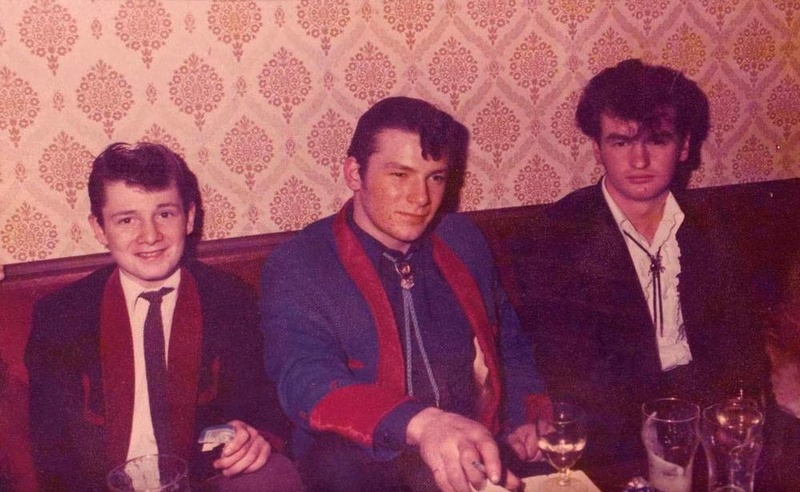
Edwardian suits and flick knives; greased quiffs and murder on the dance-floor. The original Teddy Boys not only represented a threat to the establishment in bleak post-war Britain, they also stake a serious claim as Britain's first codified youth tribe, emerging at the same time the "teenager" became a fully fledged Thing.
The subculture is often thought of as a spin-off of the rock 'n' roll revolution that hit the UK in the mid-1950s – but that isn't the case; Teddy Boy style predates all that by a good five years. As idiosyncratic and British a subculture as one is likely to find, it has changed over time – but it's never gone away.

Edwardian suits and flick knives; greased quiffs and murder on the dance-floor. The original Teddy Boys not only represented a threat to the establishment in bleak post-war Britain, they also stake a serious claim as Britain's first codified youth tribe, emerging at the same time the "teenager" became a fully fledged Thing.
The subculture is often thought of as a spin-off of the rock 'n' roll revolution that hit the UK in the mid-1950s – but that isn't the case; Teddy Boy style predates all that by a good five years. As idiosyncratic and British a subculture as one is likely to find, it has changed over time – but it's never gone away.
_________________
We don't care the People Says , Rock 'n' roll is here to stay - Danny & the Juniors - 1958
 Re: Teddy Boys
Re: Teddy Boys
"It's a pretty diehard culture – you tend to get people who have been involved for a fair percentage of their lives," Nidge explains to me. A long-term Teddy Boy, and founder of the encyclopaedic Edwardian Teddy Boy website, Nidge – real name John Van Rheede Toas – has been involved in the movement since the early 1970s and remains a passionate advocate for the scene.
"I can still remember the first time I saw a group of Teds: Blackpool Promenade, 1961. I saw these guys who were in the drape jackets – the few that remained at that point – and also leathers, because the rockers had started up by then. God knows why, but that image stayed with me," Nidge laughs. "I went to secondary school in 1968, and there were mods and rockers there. Some of the rockers wore the drainpipe jeans with coloured stripes down the side, and quiffs. It just stood out. 1972 was when I got fully into it."

Youths had started to appear on British streets in 1951 in a style of dress partly inspired by the Edwardian dandy. A rejection of post-war greyscale drabness – demob suits and the like – it was a proudly eccentric style, and one that didn't tip its cap to the established order.
The intricacies of the original dress code is a complex area, but – broadly speaking – the drape jacket (which bore some resemblance to the American zoot suits popular in the 1940s African-American jazz scene), tapered trousers and Eaton chukka boots, Eaton Clubman shoes or a pair of brogues were staple items in the early-50s. Hair-wise, a heavily greased quiff often formed the front, while a duck's arse made up a seam at the back. This was a serious look; fastidious, sharp and seductive. The clothes were often cut by specialist tailors and paid for in instalments over the course of a year: a real dedication to detail.
While the clothes alone were enough to merit more than a worried glance from the establishment, a number of events conspired to quickly galvanise criticism of the movement. On the 2nd of July, 1953, a 17-year-old called John Beckley was stabbed to death on Clapham Common by the "Plough Gang", a mob of teenagers who were, reportedly, dressed in "eccentric Edwardian suits".
The Daily Mirror headline read: "Flick knives, dance music and Edwardian suits". That, unsurprisingly, was enough to arouse conservative public opinion; before long, signs appeared in local dance halls reading: "No Edwardian clothes or rubber soled footwear."
"I can still remember the first time I saw a group of Teds: Blackpool Promenade, 1961. I saw these guys who were in the drape jackets – the few that remained at that point – and also leathers, because the rockers had started up by then. God knows why, but that image stayed with me," Nidge laughs. "I went to secondary school in 1968, and there were mods and rockers there. Some of the rockers wore the drainpipe jeans with coloured stripes down the side, and quiffs. It just stood out. 1972 was when I got fully into it."

Youths had started to appear on British streets in 1951 in a style of dress partly inspired by the Edwardian dandy. A rejection of post-war greyscale drabness – demob suits and the like – it was a proudly eccentric style, and one that didn't tip its cap to the established order.
The intricacies of the original dress code is a complex area, but – broadly speaking – the drape jacket (which bore some resemblance to the American zoot suits popular in the 1940s African-American jazz scene), tapered trousers and Eaton chukka boots, Eaton Clubman shoes or a pair of brogues were staple items in the early-50s. Hair-wise, a heavily greased quiff often formed the front, while a duck's arse made up a seam at the back. This was a serious look; fastidious, sharp and seductive. The clothes were often cut by specialist tailors and paid for in instalments over the course of a year: a real dedication to detail.
While the clothes alone were enough to merit more than a worried glance from the establishment, a number of events conspired to quickly galvanise criticism of the movement. On the 2nd of July, 1953, a 17-year-old called John Beckley was stabbed to death on Clapham Common by the "Plough Gang", a mob of teenagers who were, reportedly, dressed in "eccentric Edwardian suits".
The Daily Mirror headline read: "Flick knives, dance music and Edwardian suits". That, unsurprisingly, was enough to arouse conservative public opinion; before long, signs appeared in local dance halls reading: "No Edwardian clothes or rubber soled footwear."
_________________
We don't care the People Says , Rock 'n' roll is here to stay - Danny & the Juniors - 1958
 Re: Teddy Boys
Re: Teddy Boys
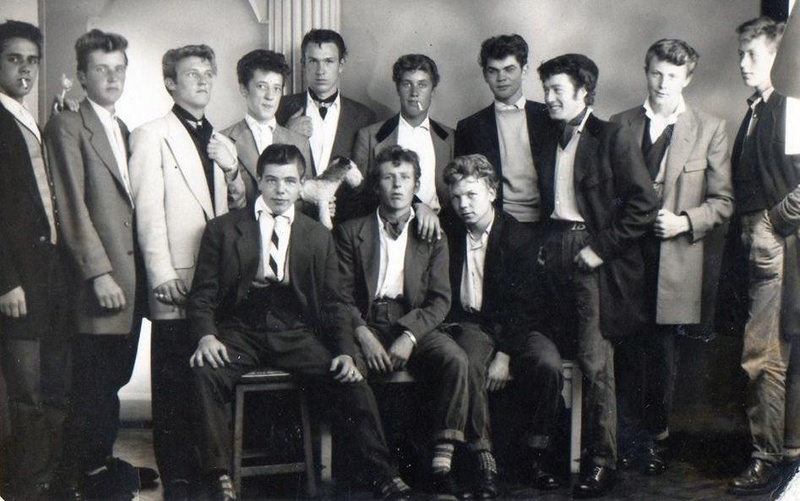
In 1956, the movie Blackboard Jungle began screening around the UK. A tale of American juvenile delinquency, it featured Bill Hayley's "Rock Around the Clock" in the opening and closing credits, and often triggered riotous behaviour among teenage audiences lapping up the alien soundtrack.
In Elephant and Castle – as well as elsewhere around London, and further afield – gang fights broke out and seats were slashed with razors when ushers told kids to stop dancing down the aisles.
While the 60s introduced plenty of other subcultural activity that the media and political order could get red-faced and frothy-mouthed about, the Teddy Boy culture remained, albeit in a slimmed-down form.

"You had the rockers and the bikers and the Hells Angels, but we got on with them, for the most part," says Nidge. "A lot of us would meet in the same pubs. There was a bit of a mixture between the leather-jacketed rockers and the Teddy Boys. As the [Teddy Boy] revival came [in the 1970s], you'd have Teddy Boys who'd wear leather jackets during the day and put the drape on at night. The two cultures fused somewhat. The leather jacket was the fighting gear and the drape was the smarter gear to take your missus out in. The Angels would like heavy rock, but also the rock 'n' roll we were into; same with the rockers."
Original rock 'n' roll – Jerry Lee Lewis, Buddy Holly, Eddie Cochran – had long been part of the Ted DNA, but the 70s brought different records and sounds to the fore. Largely based around rare rockabilly vinyl from the 1950s that hadn't seen a British release at the time, parallels can be drawn with the Northern Soul scene: this was a movement driven by the passion and knowledge of DJs and collectors scouring the crates – and often going abroad – to search out all the hidden gems. In London, the Black Raven pub in Bishopsgate became an epicentre for the revivalist scene, with Teds flocking in from all over to dance to music they couldn't hear anywhere else.
_________________
We don't care the People Says , Rock 'n' roll is here to stay - Danny & the Juniors - 1958
 Re: Teddy Boys
Re: Teddy Boys
Just as the soul scene created rabid new ears for impossibly obscure US imports, rockabilly artists like Don Woody, Sonny Burgess, Ray Campi and Mac Curtis (who were completely unknown over here while recording in the 1950s) suddenly found eager new listeners.
However, while soul heads were relatively well catered for on the radio, the BBC was not supporting the growing interest in underground rockabilly and rock 'n' roll. It was a situation that led to one of the most energising moments in Ted history – a full scale march on the BBC on the 15th of May, 1976 to protest the lack of rock 'n' roll radio.
"I was in Rhodesia at the time, else I would have been there. But 6,000 people marched that day," says Nidge. "The BBC were playing a lot of 60s stuff, but not any rock 'n' roll. A 50,000-strong petition and pilot show were handed in. Out of that march came 'It's Only Rock n Roll', the radio show, and that was an intrinsic part of the culture.
"If you were a Ted or a rocker, you'd listen on a Saturday when you were getting ready to go out. It was an underground culture in the 70s, thriving in the pubs and clubs. We'd always support the underground – the underdog – rather than mainstream artists."
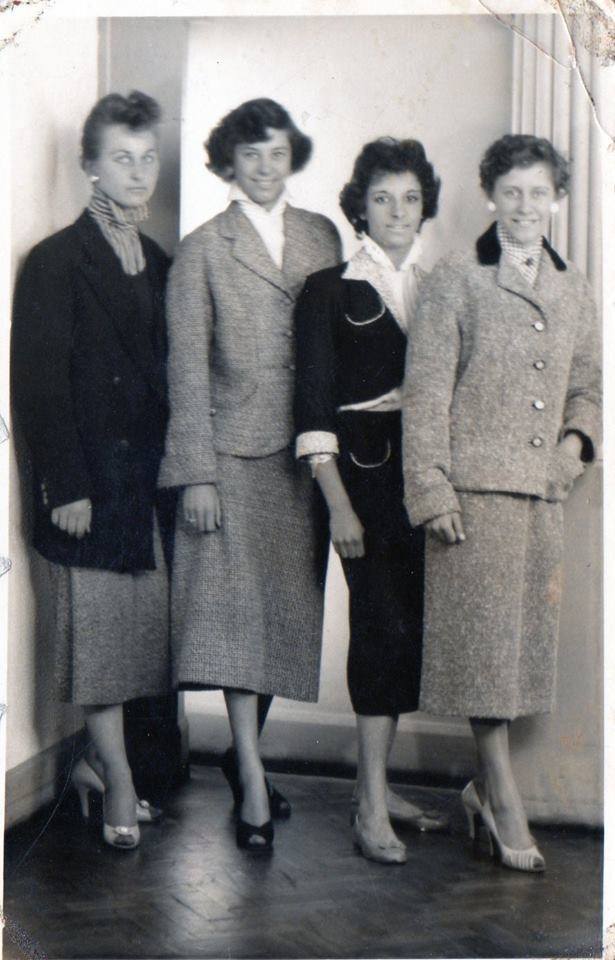
Although the Teds generally got on with rockers, attitudes changed when it came to the new breed of 1970s rockabilly kids and – later in the decade – the punks. Also around at that time were the hepcats, a younger crowd who were into American doo-wop. The "golden age" of youth cults had ushered in an often severe tribalism, one that affected most areas of cultural life. This was an era when you could get your head kicked in for having the wrong haircut, and – as Nidge recalls – people frequently did.
"There was a lot of animosity between the various youth cults in the 70s, for sure," explains Nidge. "In Leeds, where I grew up, we really got going as Teddy Boys in the early 70s. The main opposition we had were the remnants of the skinheads and the suedeheads, who evolved in the late-60s, early-70s. There was a lot of that "boot boy" culture, a spin off from the mods.
"The rockabilly culture was a spinoff from the Teds, and we didn't get on so well. Rockabilly clobber was different – jeans, hobnail boots and a checked shirt. More of a country style. After that came the hepcats, which was an American style. They liked the faster doo-wop type of rock 'n' roll, and used to mix in the same pub as us," Nidge recalls. "Towards the end of the 70s, the hepcats probably outnumbered the Teds. I used to DJ in the early-80s in Leeds, and I'd play to both audiences. I'm not saying that there wasn't violence between the two, though – I've been nose over the bar with hepcats."
However, while soul heads were relatively well catered for on the radio, the BBC was not supporting the growing interest in underground rockabilly and rock 'n' roll. It was a situation that led to one of the most energising moments in Ted history – a full scale march on the BBC on the 15th of May, 1976 to protest the lack of rock 'n' roll radio.
"I was in Rhodesia at the time, else I would have been there. But 6,000 people marched that day," says Nidge. "The BBC were playing a lot of 60s stuff, but not any rock 'n' roll. A 50,000-strong petition and pilot show were handed in. Out of that march came 'It's Only Rock n Roll', the radio show, and that was an intrinsic part of the culture.
"If you were a Ted or a rocker, you'd listen on a Saturday when you were getting ready to go out. It was an underground culture in the 70s, thriving in the pubs and clubs. We'd always support the underground – the underdog – rather than mainstream artists."

Although the Teds generally got on with rockers, attitudes changed when it came to the new breed of 1970s rockabilly kids and – later in the decade – the punks. Also around at that time were the hepcats, a younger crowd who were into American doo-wop. The "golden age" of youth cults had ushered in an often severe tribalism, one that affected most areas of cultural life. This was an era when you could get your head kicked in for having the wrong haircut, and – as Nidge recalls – people frequently did.
"There was a lot of animosity between the various youth cults in the 70s, for sure," explains Nidge. "In Leeds, where I grew up, we really got going as Teddy Boys in the early 70s. The main opposition we had were the remnants of the skinheads and the suedeheads, who evolved in the late-60s, early-70s. There was a lot of that "boot boy" culture, a spin off from the mods.
"The rockabilly culture was a spinoff from the Teds, and we didn't get on so well. Rockabilly clobber was different – jeans, hobnail boots and a checked shirt. More of a country style. After that came the hepcats, which was an American style. They liked the faster doo-wop type of rock 'n' roll, and used to mix in the same pub as us," Nidge recalls. "Towards the end of the 70s, the hepcats probably outnumbered the Teds. I used to DJ in the early-80s in Leeds, and I'd play to both audiences. I'm not saying that there wasn't violence between the two, though – I've been nose over the bar with hepcats."
_________________
We don't care the People Says , Rock 'n' roll is here to stay - Danny & the Juniors - 1958
 Re: Teddy Boys
Re: Teddy Boys
While animosity was mostly kept to a minimum among the Teds and other youth tribes, a special breed of aggression was reserved for the punk movement.
"The punks – that was different," says Nidge. "We would fight regularly with them. We saw it as an affront. They were appropriating Ted gear and then messing it up. It was basically down to Vivienne Westwood, who had the shop Let it Rock and sold drapes that she'd then customise. It could get pretty bloody serious, actually – flick knives and knuckle dusters... all sorts. These days, it's completely different. I was at a weekender recently and there was some punk guy there and nobody batted an eyelid."

Since the late 70s, the movement has experienced its peaks and troughs (as with many subcultures, the 80s were not a kind decade). However, in the 1990s, two sisters formed The Edwardian Drape Society in North London to bring Teds together. The club itself doesn't meet too regularly these days, but they do hold regular events under the "Tennessee Club" banner, and throw "The Wildest Cats in Town" weekender, two days of music, dancing and vintage car appreciation attended by Teds, rockabillys, rockers and a fair percentage of what Nidge describes as "weekenders – jive bunnies; they wear the Ted gear to dance in, but don't take it further".
But what, I wondered, would become of the movement? Will it survive the next 50 years? Nidge points to tensions between the more purist element of the Edwardian scene and the 70s revivalists, but maintains that there will probably always be an underground keeping the faith.
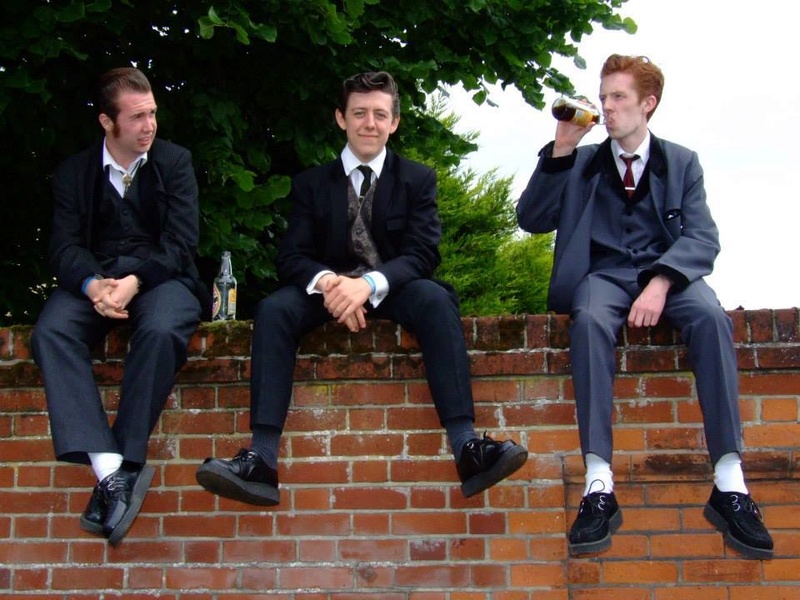
"A lot of original Teds are popping their clogs these days," he says. "It gets depressing as you get older – you start going to more funerals than weddings. Weekenders have been the lifeblood of the scene, though. Obviously Wildest Cats in Town, then you have the Skegness Stomp, which is pretty much 100 percent Teds; The Ted Do in Blackpool and also the Rockers Reunion.
"There was a bit of a wane at the end of the 70s. A lot of people left it, got married, moved on... but they're coming back now that the kids have left home. The fear is that it could become watered down. We want to get the youngsters on board and get them in the right mindset to carry it on into the future, and I'm sure they will. There are a fair few of them around now, and it's my hope that these folk will continue it properly."
@HarrySword
"The punks – that was different," says Nidge. "We would fight regularly with them. We saw it as an affront. They were appropriating Ted gear and then messing it up. It was basically down to Vivienne Westwood, who had the shop Let it Rock and sold drapes that she'd then customise. It could get pretty bloody serious, actually – flick knives and knuckle dusters... all sorts. These days, it's completely different. I was at a weekender recently and there was some punk guy there and nobody batted an eyelid."

Since the late 70s, the movement has experienced its peaks and troughs (as with many subcultures, the 80s were not a kind decade). However, in the 1990s, two sisters formed The Edwardian Drape Society in North London to bring Teds together. The club itself doesn't meet too regularly these days, but they do hold regular events under the "Tennessee Club" banner, and throw "The Wildest Cats in Town" weekender, two days of music, dancing and vintage car appreciation attended by Teds, rockabillys, rockers and a fair percentage of what Nidge describes as "weekenders – jive bunnies; they wear the Ted gear to dance in, but don't take it further".
But what, I wondered, would become of the movement? Will it survive the next 50 years? Nidge points to tensions between the more purist element of the Edwardian scene and the 70s revivalists, but maintains that there will probably always be an underground keeping the faith.

"A lot of original Teds are popping their clogs these days," he says. "It gets depressing as you get older – you start going to more funerals than weddings. Weekenders have been the lifeblood of the scene, though. Obviously Wildest Cats in Town, then you have the Skegness Stomp, which is pretty much 100 percent Teds; The Ted Do in Blackpool and also the Rockers Reunion.
"There was a bit of a wane at the end of the 70s. A lot of people left it, got married, moved on... but they're coming back now that the kids have left home. The fear is that it could become watered down. We want to get the youngsters on board and get them in the right mindset to carry it on into the future, and I'm sure they will. There are a fair few of them around now, and it's my hope that these folk will continue it properly."
@HarrySword
_________________
We don't care the People Says , Rock 'n' roll is here to stay - Danny & the Juniors - 1958
 Re: Teddy Boys
Re: Teddy Boys
_________________
We don't care the People Says , Rock 'n' roll is here to stay - Danny & the Juniors - 1958
Dj Eddie-Cesc- Messages : 576
Date d'inscription : 03/07/2015
 Teddy Boys 1956
Teddy Boys 1956
_________________
We don't care the People Says , Rock 'n' roll is here to stay - Danny & the Juniors - 1958
 Re: Teddy Boys
Re: Teddy Boys
_________________
We don't care the People Says , Rock 'n' roll is here to stay - Danny & the Juniors - 1958
 The Barleycorn Great Southsea Street, Portsmouth 1958
The Barleycorn Great Southsea Street, Portsmouth 1958
_________________
We don't care the People Says , Rock 'n' roll is here to stay - Danny & the Juniors - 1958
Page 4 sur 6 •  1, 2, 3, 4, 5, 6
1, 2, 3, 4, 5, 6 
 Sujets similaires
Sujets similaires» Documentary 1972 - Teddy Boys
» General Lee & Teddy Boys - paris 13éme 1979
» Vidéo Teddy Boys in London Club - 1977
» Sex Pistols - Malcolm McLarren, Rock'n'roll to punk - Teddy boys and Punk Rockers et shop Let it Rock
» The Teds - Chris Steele-Perkins & Richard Smith - Photographie Teddy boys late 70s early 80s
» General Lee & Teddy Boys - paris 13éme 1979
» Vidéo Teddy Boys in London Club - 1977
» Sex Pistols - Malcolm McLarren, Rock'n'roll to punk - Teddy boys and Punk Rockers et shop Let it Rock
» The Teds - Chris Steele-Perkins & Richard Smith - Photographie Teddy boys late 70s early 80s
Page 4 sur 6
Permission de ce forum:
Vous ne pouvez pas répondre aux sujets dans ce forum
 Connexion
Connexion